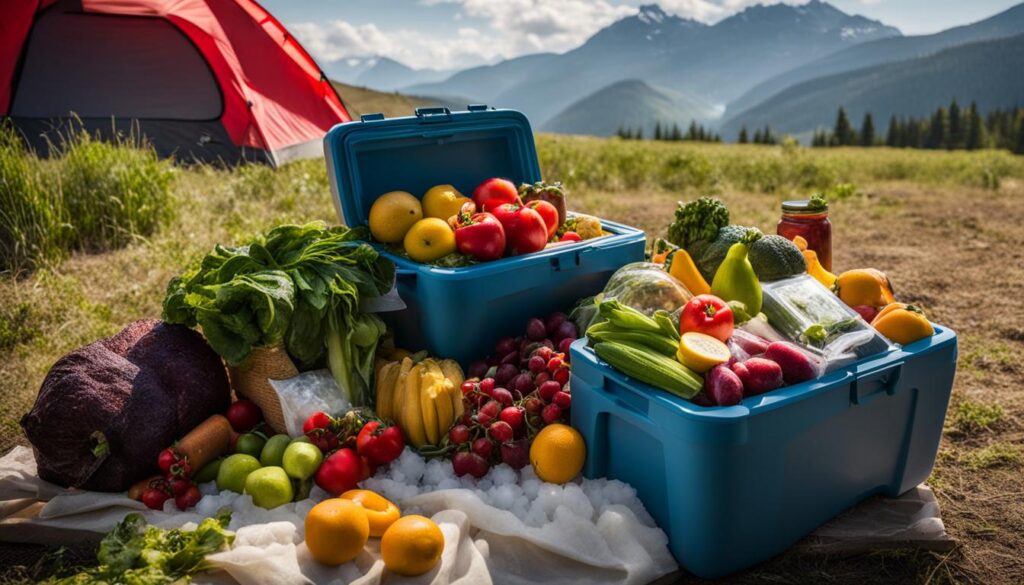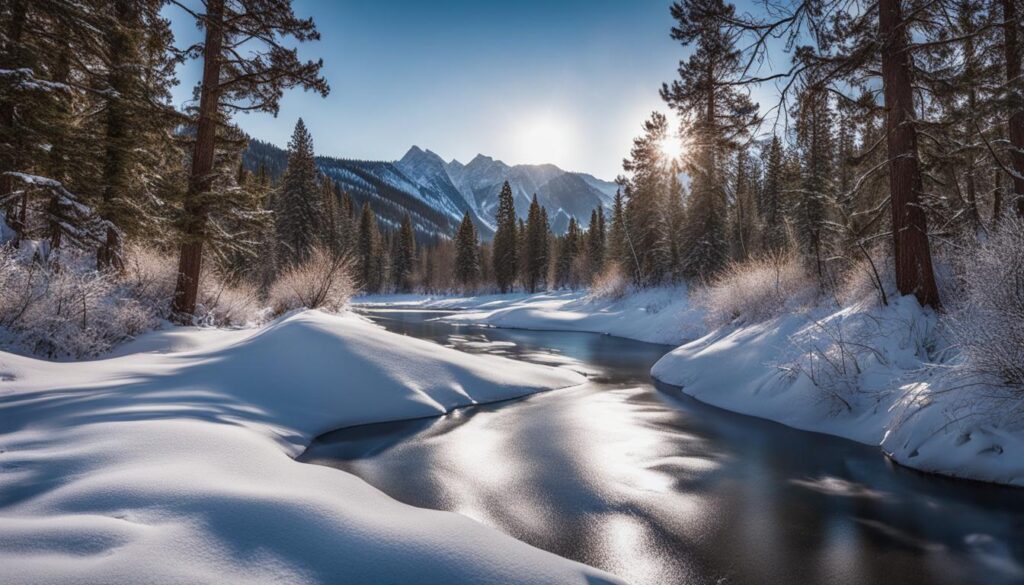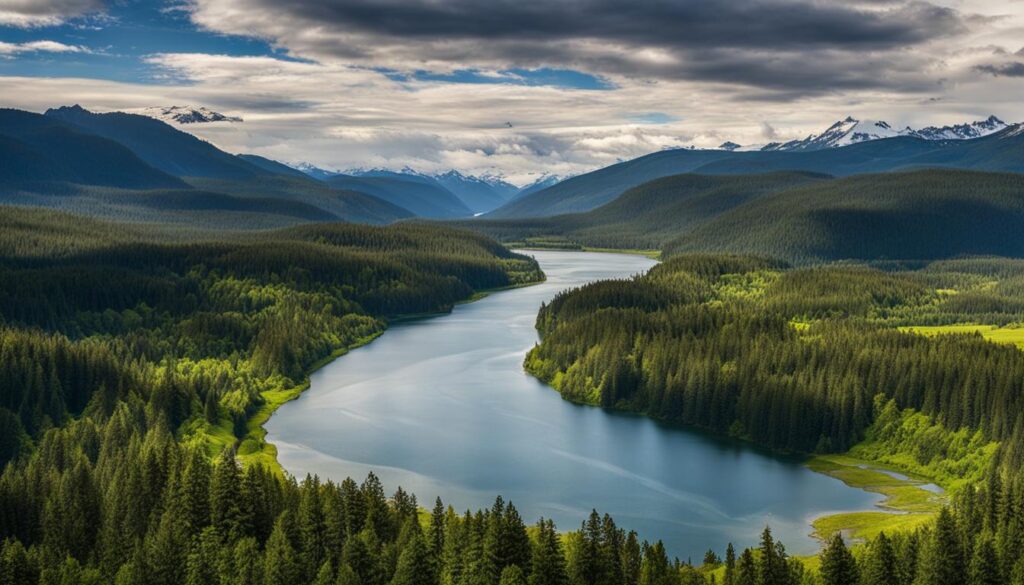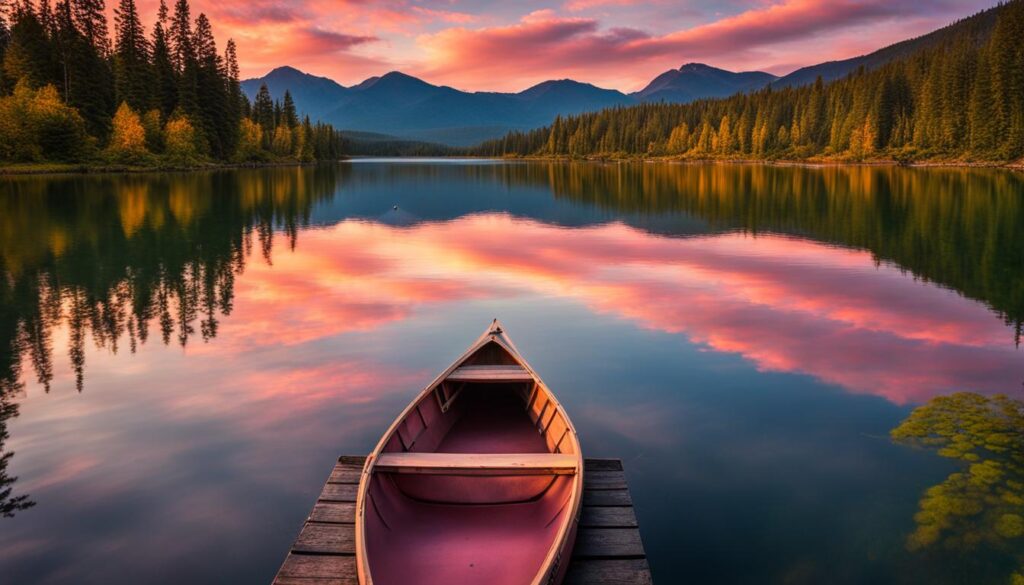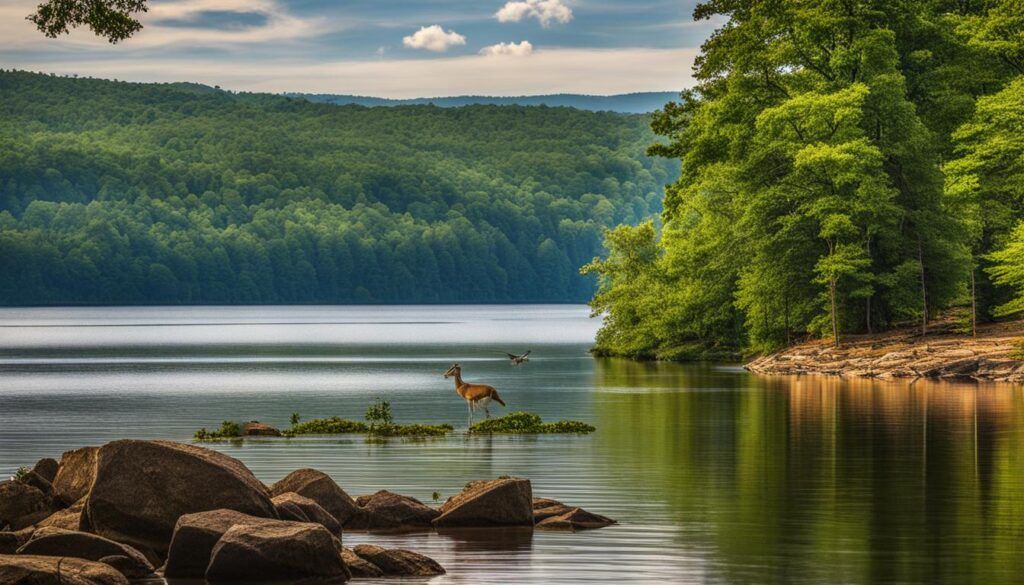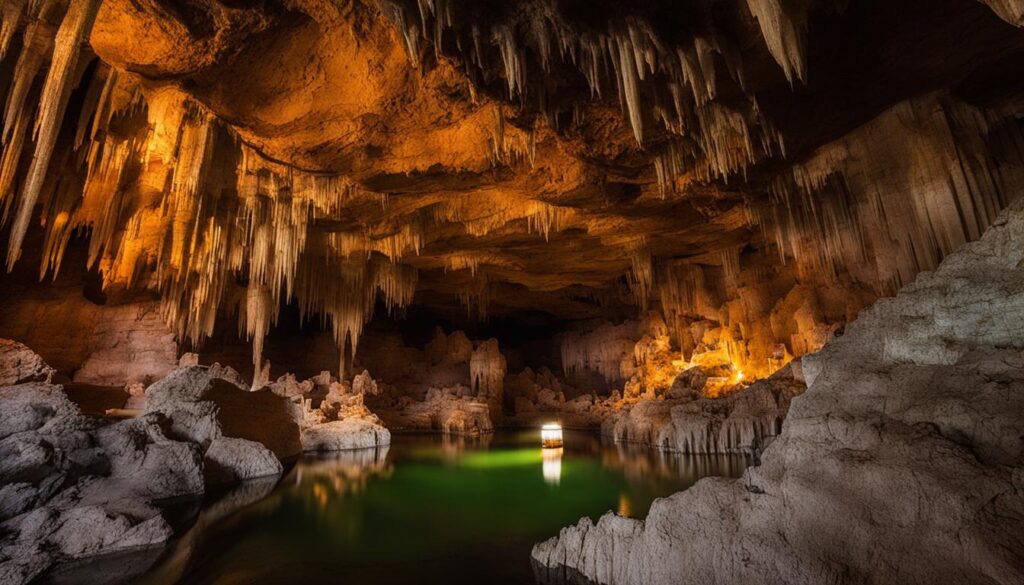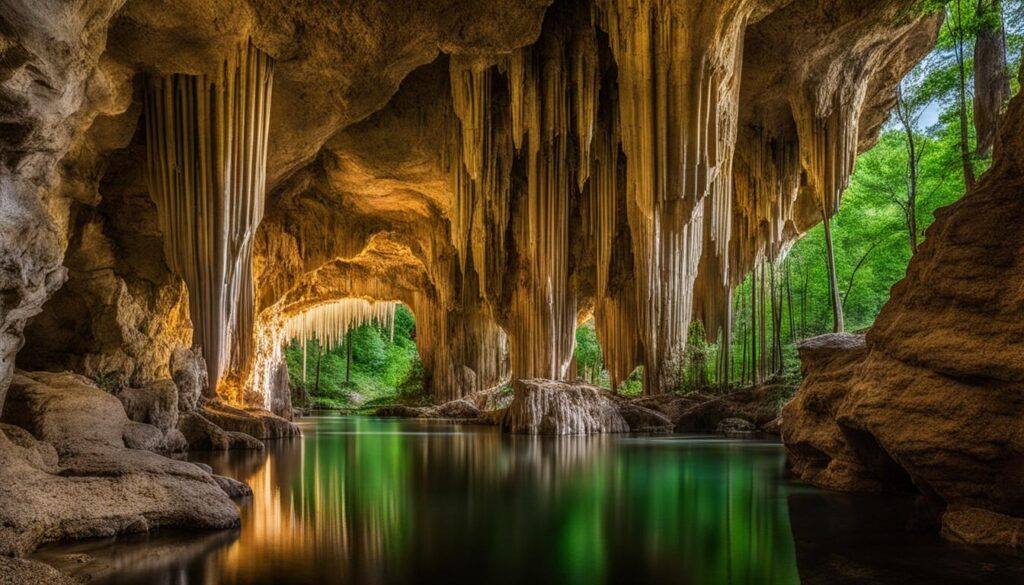When heading out into the great outdoors for a camping adventure, it’s crucial to keep your food cold and fresh. Proper camping food storage is essential for maintaining the quality of your perishable items and ensuring they remain safe for consumption throughout your trip. To help you make the most of your camping experience, here are some top tips and tricks to keep your food cold while camping.
Key Takeaways:
- Invest in a high-quality cooler that is well-insulated to keep your food cold for longer.
- Separate your food and drinks into different coolers to limit the number of times the food cooler is opened.
- Organize your cooler strategically to ensure easy access to beverages without frequent opening of the food cooler.
- Use ice packs or freeze water in jugs to keep your food cold and have the added benefit of chilled drinking water.
- Consider using dry ice if you need to keep food frozen for an extended period.
- Choose a shady location for your cooler and avoid heat-generating objects to maximize its effectiveness.
- Plan meals with non-perishable ingredients and pack backup non-perishable snacks to prevent food spoilage.
By following these tips and tricks, you can ensure that your food stays cold, fresh, and safe during your camping adventures.
Stay tuned for our upcoming sections, where we will delve deeper into each of these strategies for keeping your food cool while camping.
Contents
Choose a High-Quality Cooler
Investing in the right cooler is crucial to ensure that your food stays cold and fresh during your camping trips. When selecting a cooler, prioritize high-quality options that offer excellent insulation and durability. Look for coolers that are specifically designed for camping and outdoor activities, as they are built to withstand rugged conditions and provide optimal insulation.
One of the key factors to consider when choosing a camping cooler is insulation. Look for coolers that have thick walls and effective insulation materials, such as high-density foam. These features help to maintain the internal temperature of the cooler and prevent outer heat from affecting the contents inside. Brands like YETI are renowned for their superior insulation properties, making them a popular choice among outdoor enthusiasts.
In addition to insulation, consider the size and capacity of the cooler. Ensure that the cooler has ample space to accommodate your food and beverages, without overcrowding. It’s also beneficial to have separate coolers for food and beverages to minimize the frequency of opening the cooler, which can lead to heat entering and compromising the internal temperature.
When selecting a camping cooler, pay attention to the quality of the materials used. Opt for coolers that are made from sturdy and durable materials, such as rotomolded plastic or heavy-duty fabric. This ensures that your cooler can withstand the rigors of outdoor use, including rough handling, extreme temperatures, and exposure to the elements.
“Investing in a high-quality cooler is a wise decision for campers who want to keep their food fresh and safe. A reliable cooler with superior insulation and sturdy construction will make a significant difference in preserving perishable items during camping trips.”
Top Camping Coolers
| Brand | Insulation | Capacity | Price Range |
|——————–|—————————-|————————|—————|
| YETI | Thick walls, high-density foam | Various sizes (20-350 quarts) | $$$ – $$$$ |
| Coleman | Thick insulation layers | Various sizes (28-150 quarts) | $$ – $$$ |
| Igloo | Ultratherm insulation | Various sizes (25-150 quarts) | $ – $$$ |

Choosing the right cooler is essential for preserving the freshness of your food while camping. With options like YETI, Coleman, and Igloo, you can find a high-quality cooler that suits your needs and budget. Prioritize insulation, durability, and capacity when making your selection, and remember to keep your cooler closed as much as possible to maintain the optimal temperature inside.
Keep Your Cooler Closed and Organized
When it comes to keeping your food cold while camping, one of the most important factors is to minimize the time your cooler is open. Each time you open the cooler, warm air enters, and the cold air escapes, causing the temperature inside to rise. This can lead to a decrease in the freshness of your food and increase the risk of spoilage.
One effective strategy to prevent food spoilage and maintain the cold temperature of your cooler is to keep your food and drinks separated in different coolers. By doing so, you can access beverages without having to frequently open the food cooler. This prevents unnecessary exposure to warm air and helps maintain a consistent cold temperature for your perishable items.
Organizing your cooler is another important aspect of keeping your food cold while camping. By organizing the contents of your cooler, you can easily find what you need without spending too much time searching through the items. This also minimizes the amount of time the cooler is open. Place frequently accessed items, such as beverages, near the top, while perishable foods should be stored at the bottom of the cooler.
Furthermore, it’s recommended to prepare your meals before your camping trip. This includes pre-chopping ingredients, marinating meats, and pre-cooking any dishes that can be reheated later. By doing this, you reduce the time spent handling food inside the cooler, further preventing temperature fluctuations and food spoilage.
An additional technique to enhance cooling is to place frozen or perishable items at the bottom of the cooler. This ensures that these items benefit from direct contact with the ice or ice packs, which helps maintain their freshness for longer. Be sure to properly pack them to prevent cross-contamination and ensure food safety.

By implementing these proper cooling techniques and organizing strategies, you can effectively prevent food spoilage while camping. Keeping your cooler closed as much as possible and organizing its contents will help maintain a consistently cold temperature, keeping your perishable items fresh and safe to eat.
Use Ice Packs and Dry Ice
When it comes to keeping your food cold while camping, ice packs are a convenient and mess-free solution. They help maintain the temperature in your cooler without the worry of melted ice leaking onto your food. To make your own ice packs, simply fill plastic jugs or bottles with water and freeze them before your trip. As the ice melts, you’ll have cold drinking water readily available.
If you need to keep food frozen for an extended period, consider using dry ice. Dry ice is a solid form of carbon dioxide that can keep your food frozen for a much longer time than regular ice. It’s readily available at many grocery stores. Remember to handle dry ice with care and follow the proper safety precautions, as it can cause severe burns if not handled correctly.
Benefits of Using Ice Packs and Dry Ice:
- Convenience: Ice packs are easy to prepare and use, making them a hassle-free option for keeping your food cold.
- Mess-free: Unlike regular ice, ice packs don’t melt into water, eliminating the risk of leaks and soggy food.
- Extended freshness: Dry ice can keep your food frozen for a longer period, ensuring that perishable items remain fresh throughout your camping trip.
By utilizing ice packs and dry ice, you can ensure that your camping food stays cold and safe to eat. Just remember to handle dry ice with caution and follow the instructions provided by the manufacturer.

Take Advantage of Cool Environments
When it comes to campsite food safety and keeping perishable food fresh while camping, one of the simplest yet effective strategies is to take advantage of cool environments. By harnessing the natural coolness of certain areas, you can significantly extend the freshness of your food and reduce the risk of spoilage.
First and foremost, when setting up your campsite, opt for a shady location that is shielded from direct sunlight. Sunlight and heat can accelerate the melting of ice in your cooler, leading to a faster rise in temperature and potential food spoilage. Placing your cooler in the shade helps maintain a cooler internal temperature and prolongs the life of your perishable items.
In addition to avoiding direct sunlight, it is crucial to steer clear of heat-generating objects such as grills or campfires. These can emit heat that can adversely affect the insulation properties of your cooler, making it less efficient in keeping your food cold. By keeping your cooler away from sources of heat, you can maximize its cooling capabilities and ensure your food stays fresh for longer.

A central idea to keep in mind is to utilize the surrounding cool environments to your advantage. This can include finding spots with natural shade, such as under trees or near large rocks, as well as exploiting natural wind patterns to enhance ventilation around your cooler. By strategically positioning your cooler in a cool and well-ventilated area, you can optimize its performance and maintain the freshness of your perishable food throughout your camping trip.
Key Takeaways:
- Choose a shady location away from direct sunlight to set up your campsite.
- Avoid placing your cooler near heat-generating objects like grills or campfires.
- Utilize natural shade, wind, and ventilation to maximize the cooling efficiency of your cooler.
| Benefits of Taking Advantage of Cool Environments for Campsite Food Safety | Challenges to Consider |
|---|---|
| Extended freshness of perishable food | Potential limited availability of shaded areas |
| Reduced risk of food spoilage | Variability in natural wind patterns |
| Better utilization of cooler’s insulation properties | Need for strategic planning and site selection |
Plan Non-Perishable Meals and Bring Backups
When it comes to camping, preventing food spoilage is crucial for a safe and enjoyable trip. One effective strategy is to plan meals that rely on non-perishable ingredients. Items like jerky, sausages, cheese, and dehydrated fruits and meats are excellent options that can last for an extended period in a cooler.
In addition to non-perishable meals, it’s wise to pack non-perishable snacks as backups. This ensures that even if some of your perishable items spoil, you still have delicious options to enjoy during your camping adventure.
By being prepared with non-perishable choices, you can minimize the risk of food spoilage while camping and have peace of mind knowing that you have reliable and tasty alternatives available. So, make sure to include these non-perishable options in your camping food storage plan, and you’ll have worry-free meals throughout your entire trip.
FAQ
What are some tips for keeping food cold while camping?
Some tips for keeping food cold while camping include investing in a high-quality cooler, keeping your cooler closed and organized, using ice packs and dry ice, taking advantage of cool environments, and planning non-perishable meals and bringing backups.
How do I choose a high-quality cooler for camping?
When choosing a high-quality cooler for camping, look for one that is well-insulated with thick walls. Brands like YETI are known for their durability and excellent insulation. Consider using separate coolers for food and beverages, and ensure the cooler has a tight seal to keep the cold air inside.
What can I do to keep my cooler closed and organized?
To keep your cooler closed and organized, separate your food and drinks into different coolers. This will limit the amount of time the cooler is open and help maintain the cold temperature. Additionally, pack your cooler in a way that allows for easy access to beverages without opening the food cooler frequently.
What are some options for ice packs while camping?
To keep your food cold without the mess of melted ice, consider using ice packs made from freezing water in plastic jugs or bottles. These will serve as ice packs to keep your food cold, and as the ice melts, you’ll have cold water to drink. If you need to keep food frozen for a longer period, consider using dry ice, which can keep food frozen without the need for regular ice.
How can I take advantage of cool environments while camping?
When setting up your campsite, choose a shady location away from direct sunlight and heat-generating objects. Keeping your cooler in the shade will help prevent the ice from melting quickly. Avoid placing your cooler near a grill or campfire, as the heat can affect its insulation.
What should I do to prevent food spoilage while camping?
To prevent food spoilage while camping, plan meals that rely on non-perishable ingredients. Foods like jerky, sausages, cheese, and dehydrated fruits and meats are great options that can last for a long time in a cooler. It’s also a good idea to pack non-perishable snacks as backups, in case your perishable items spoil.
